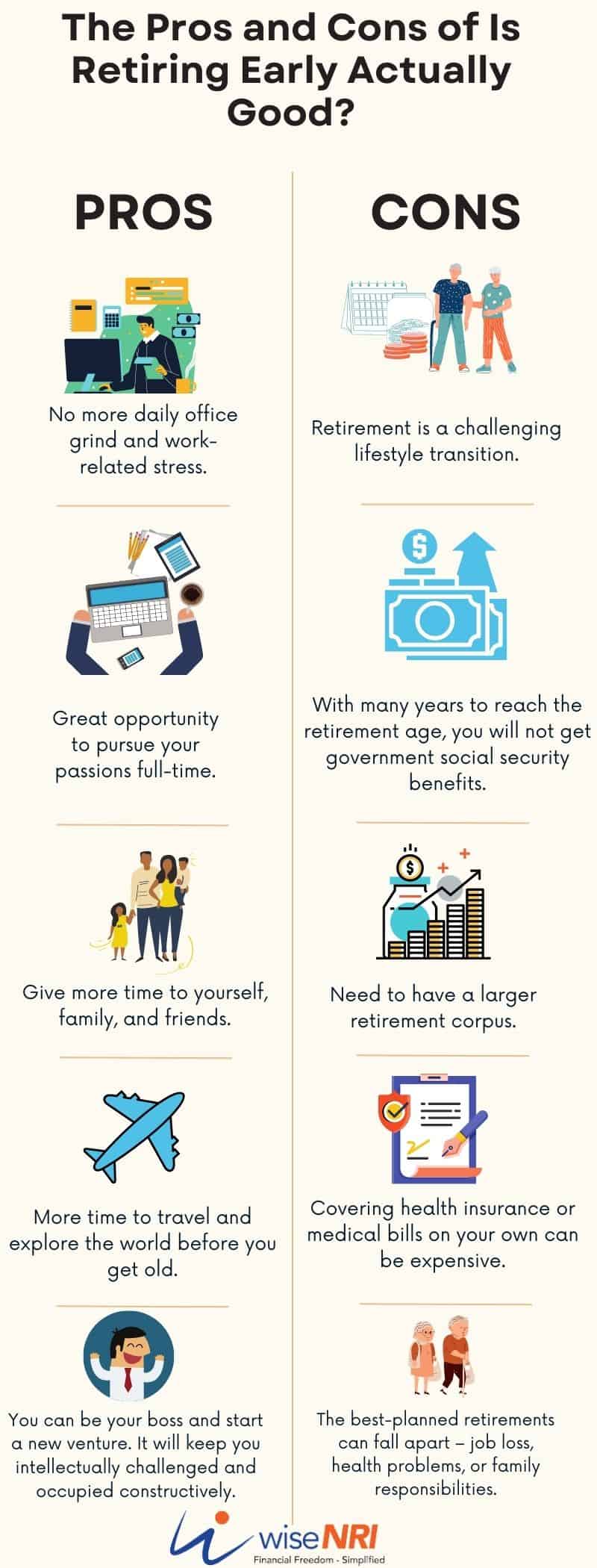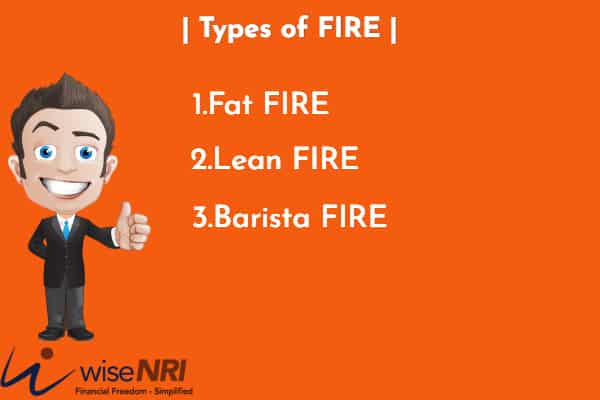“The Great Resignation” has caught the fancy of far too many in the developed economies that it has shaken the foundations of companies there.
The burnout, continuous work-from-home, and the desire to achieve a more stable work/life balance have all contributed to the new fad. One other reason that has contributed to it is the growing longing among the people to retire early.

Must Read – Mr. NRI – Time Is Money When it Comes to Retirement Planning !
The 1992 seminal book by Vicki Robin and Joe Dominguez, “Your Money or Your Life” first discussed the FIRE strategy. Since then, FIRE has now transformed into a movement with forums and clubs dedicated to discussing strategies.
Many young NRIs are also building their investments around the FIRE strategy. Most of them have planned it to the last penny.
Is Retiring Early Actually Good?
For the majority of the millennials and gen Z, it is a dream is to retire early. And they are doing everything in their hands to realize it.
Pros
- No more daily office grind and work-related stress.
- Great opportunity to pursue your passions full-time.
- Give more time to yourself, family, and friends.
- More time to travel and explore the world before you get old.
- You can be your boss and start a new venture. It will keep you intellectually challenged and occupied constructively.
Cons
- Retirement is a challenging lifestyle transition.
- With many years to reach the retirement age, you will not get government social security benefits.
- Need to have a larger retirement corpus.
- Covering health insurance or medical bills on your own can be expensive.
- The best-planned retirements can fall apart – job loss, health problems, or family responsibilities.

Must Check – Mr. NRI – How Much Retirement Corpus Is Enough
Where to Retire?
An NRI at least has the option to think about retiring in the country of their residence or India. But most countries where the standard of living is better than India, have a higher cost of living. Therefore, retiring early there is possible with only a larger nest egg.
Retiring in India has many advantages:
- Coming back to family and friends.
- The medical facilities are now comparable to the best in the world.
- You can afford to buy a spacious home or farmhouse.
- Benefit from saving in Dollars and spending in Rupee.
- Get cheap labour that you can never afford in developed countries.
How do NRIs Implement FIRE Method?
FIRE stands for financial independence, retire early.
The FIRE practitioners propose – live frugally, save up to 70% of annual income, and make judicious long-term investments. The idea of frugal living may be different for each person, and how much is enough for retirement also varies from person to person.
It also assumes that lifelong you would need only as much as you have calculated in your Excel sheet. And we all know firsthand, that this is one of the strangest, if not the stupidest assumptions.
The primary goal, in any case, is becoming financially independent asap. Whether to retire, once that milestone is crossed, is a decision you may take on a later date.
Also, even after amassing the estimated corpus, you can continue to work.
But you will be free to work or not. You can choose your boss or cause to work for. You can choose to be paid or work free.
The keyword here is choice.
Implementing the FIRE strategy requires more effort, discipline, and lifelong tracking of expenses, not only today.

Must Check – Best Places To Retire
Types of FIRE
Over the years, many interpretations of the FIRE strategy have evolved. Some FIRE practitioners desire financial independence while others just want to retire early.
As evident, FIRE isn’t a one-size-fits-all journey.
Fat FIRE
Best suited for those who wish to continue their current standard of living. They would need to earn more and save considerably higher than the average worker. They also need more aggressive savings and investment strategies.
Lean FIRE
At the other extreme is the worker who can live frugally with minimum needs. She already has a minimalistic lifestyle and wishes to do so in her retirement. She can easily afford to save more to reach the desired target of 25x annual expenses.
Barista FIRE
This is a middle ground and tries to strike a balance between earnings and savings. The practitioners do this by becoming financially independent but continue to work part-time and gigs. They supplement their less-than-ideal corpus or a more than minimalist lifestyle by earning something as compared to nothing.
Must Check – Why Should NRIs Save For Early Retirement? Guide for Saving for Retirement
Is FIRE for You?
Depends.
Just like anything in personal finance, it is also an extremely personal decision. You must consider many factors before you the plunge.
- You are a high earner with a high savings rate and can afford to live minimalistic.
- You are more interested in experiencing life rather than earning lifelong.
- You are earning in Dollars and plan to retire in India, making it simpler.
Even if you start working on it today, you can come back to working life again – at least as a gig or part-time worker.
To make FIRE work for you, you need:
- High Savings Rate: you need it higher than regular to reach the target early. In some cases, practitioners save up to 70% of their incomes!
- Small Corpus: the retirement corpus target is kept smaller with a minimalistic lifestyle at the center of it. It is suggested to be at least 25x your annual expenses. The more the better
- Low Withdrawal Rate: it is assumed at 4% of the initial corpus would be withdrawn steadily over your lifetime, while the rest would continue to grow.
Let us understand using a few examples.
Case 1
Minakshi earns $70,000 a year, with zero retirement savings. If she saves only 20% of her income and invests it in 8% annual yield instruments. Her 25x mark will be around $1.4 million ($56,000 * 25). To cross this mark, she will need about 28.5 years.
Case 2
Latha earns $60,000 annually, with nothing saved. She starts saving 50% of her income and invests it in an 8% instrument. Her retirement mark is set way lower at $750,000 because of lesser living expenses. She can reach her target in a little more than 14 years!
Case 3
Mohnish and Vasudha earn collectively $100,000 a year. They plan to retire in India. with zero initial savings, they start saving 30% of their annual income. They can reach the target in close to 23 years with all the other assumptions being the same. But even at the current exchange rate, they will retire with Rs. 13.12 crores in India. Here they can manage a decent lifestyle.
Barriers and Risks
- Debts: Whether it is a student loan or home loan, you must pay them off. Therefore, the initial years’ savings can be consumed entirely in loan repayments and your retirement can move by 5 to 8 years.
- Living long: Retirees always face the risk of outliving their corpus. This can be a result of more than planned expenditure, emergencies, or subdued returns.
- You are Never Free: Not working for money is not going to be too much different if you turn into a penny-pincher.
- Too much to ask for: This journey requires making sacrifices and living a lifestyle that requires less than what you are used to. You may adopt it, but your life partner or children may resent it.
Bottom Line
While wanting to retire at 30 is unrealistic for most people, it is a growing trend among millennials. Even by planning to retire early, one shows enough financial maturity and preparedness in her 20s that is not found in many even in their 40s.
Even if you take becoming financially independent as the key message from this, then our job is well done. To be financially independent, you need to start saving and investing in long-term assets.
Have you tried FIRE or any other early retirement strategy – please share in the comment section…

Save AT LEAST the same percentage of your income as your AGE. If you are 25 you should be saving AT LEAST 25% of your income. The remaining 75% is enough to manage Income Tax, rent (or mortgage) & other living expenses. Having a 2 income family makes it possible to save more well over 25% of combined income.
Continuing the example, at age 26 you should save at least 26%…at age 40 you should be saving at least 40%.
The increased savings is made possible thanks to annual increases in income from increments, promotions etc.
Most important is then to invest the savings in SAFE mutual funds so that the savings compounds at a rate well over inflation. Fixed Deposits will not offer high compounding.